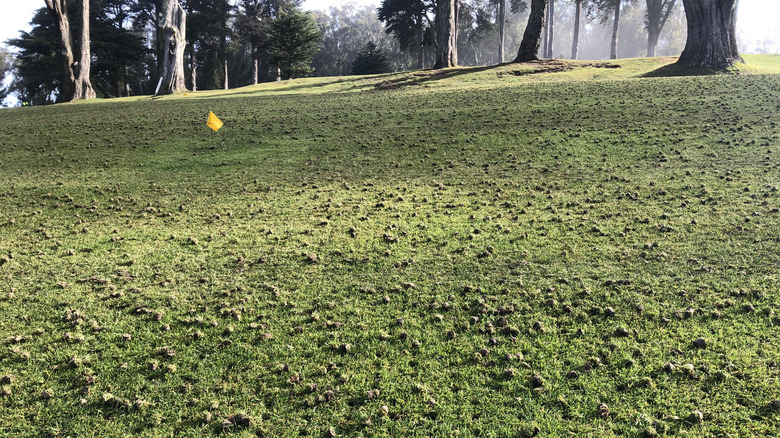The Downsides To Lawn Aeration That You Should Know About
Before you poke holes in your lawn, it's probably a good idea to poke some holes in the assumptions you've been making about lawn care. Psychologists and philosophers say this is difficult because our brains are designed to defend prior commitments, not necessarily to know things. That is, if you think you should aerate your lawn four times a year, you're unlikely to be dissuaded. The best thing to do (to your brain, figuratively, and not to your lawn) is blow things up and start from scratch. Because it turns out that aeration has some important downsides, from the mess it makes to the fact that it can actually make your soil compaction problem worse and damage your lawn in other ways.
The original purpose of core aeration — removing little cylinders of soil — was relieving soil compaction and helping turfgrass root systems get easier access to resources like air, water, and nutrients. This makes for better root mass development and, consequently, healthier turfgrass. Along the way, core aeration can reduce thatch, which also helps with access to resources. So the question is this: Does your lawn need relief from soil compaction, or better access to nutrients, better water, and air movement?
YouTuber Lawncology argues convincingly that core aeration is a recovery practice that isn't necessary most of the time. In other words, you don't need to use it as a stand-in for cultural practices that will achieve the same goal of creating healthy soil structure — and do it sustainably. This includes watering properly, mowing in a way that avoids stress to turfgrass, and fertilizing effectively by introducing organic material to the soil where necessary.
The biggest downside: Making soil compaction worse
The worst of soil aeration's downsides is that it can make a soil compaction problem worse. Let's say you've read the signs that say you need to aerate your lawn. One major complication of lawn aeration is that a lot of what we do is not aeration at all. Driving spikes into your lawn with a heavy device is ineffective and counterproductive. The heavy machine compacts the soil further, and the spikes actually push the soil around them into smaller spaces, which is (you guessed it) compaction. So core aeration is almost always a better option than spike aeration, but heavy core aeration machines can undermine your efforts as well.
This is a big deal because — in addition to restricting turfgrass's access to air, water, and nutrients — compacted soil can lead to poor percolation of aqua into the soil. This leads to water collecting on the surface, so the first few inches of soil become waterlogged, and an increase in runoff leads to soil erosion. The waterlogged root zone results in increased disease and shallow roots, which in turn leads to thinner grass, hotter soil, and ineffective seeding.
If your soil doesn't have these problems, you certainly don't want to introduce them. The soil's structure should be about half air space. Since that's kind of hard to determine, the Virginia Cooperative Extension recommends removing a 12-by-12-inch square of soil that's 6 inches deep. If grass roots don't extend deeper than 1 or 2 inches, your soil structure will probably benefit from proper aeration. Otherwise, it might be a risk.
Other problems that arise from core aeration
Even if you really need to rent a core aerator for your lawn, there will be downsides. Obviously, core aeration is stressful to your turfgrass, since you're cutting through its roots and then exposing them. Aeration also penetrates the thatch layer, negating the effectiveness of pre-emergent herbicides that create a chemical barrier in the thatch. And core aeration is a slow, curative process designed to correct an existing problem you could have avoided in the first place, alongside other strategies for saving your lawn from issues caused by compacted soil.
It can also be hard work to use and move a heavy core aeration machine without damaging your lawn. To say nothing of gathering up all the removed cores, breaking them up, and redistributing them around the lawn in order to undo the deficits you created with core aeration in the first place. (You can also leave them on the lawn to disintegrate in the next few rains, though this seems like an unlikely approach for someone concerned about the appearance of a lawn.)
An Agronomy Journal study on the effect of aeration on golf course turfgrass found that grass quality declined for about four weeks after aeration, so that might also be something to prepare yourself for. The study is also interesting in that it raises questions about the gains you can expect from aeration. Reductions in bulk density, surface hardness, and thatch all seemed modest. And, maybe most worrisome, less frequent aeration seemed to result in both better-looking grass and lower soil quality. But try telling your brain that.

